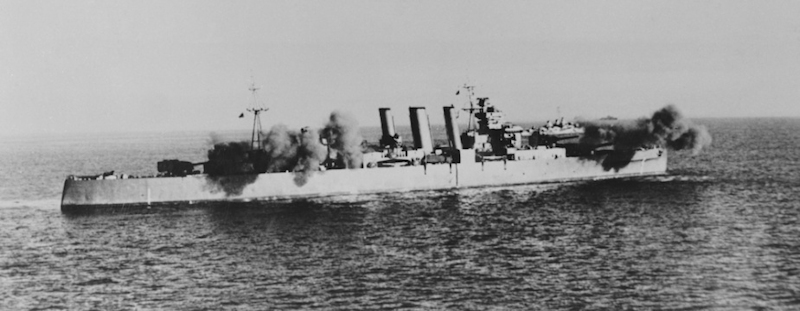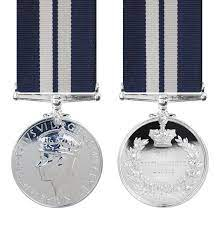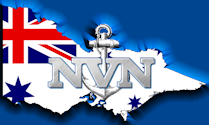Able Seaman Robert Henry (Tubby) WELLARD DSM
 Robert
Henry Wellard, o/n 18867, was born on 28 April 1908, in the
small town of Dookie, situated in a valley between Mount
Major and Mount Saddleback in the Goulburn Valley region of
Victoria and joined the Royal Australian Navy on 6th
December 1927. Robert
Henry Wellard, o/n 18867, was born on 28 April 1908, in the
small town of Dookie, situated in a valley between Mount
Major and Mount Saddleback in the Goulburn Valley region of
Victoria and joined the Royal Australian Navy on 6th
December 1927.
The following was originally
written by CMDR Warwick Bracegirdle DSC** and later edited
by his son, LCDR Nicholas Bracegirdle.
25/26 October 1944
HMAS SHROPSHIRE took part in one of the greatest naval
gunnery battles of all time -
the Battle of Surigao Straits near Leyte.
A. B. 'Tubby' Wellard distinguished himself during that
Night Action.
Here is how Tubby won his DSM.
Able Seaman "Tubby" Wellard was large and always smiling.
Nothing ever seemed to upset him. His daily job in the
8" cruiser, H.M.A.S. Shropshire, was Gunner's
Yeoman. You nearly always found him in the gunners'
store surrounded with spares for all kinds of armament.
Like a floating section of a Woolworth's store, he kept
everything from rifle spares, Very pistols, machine guns to
the breech blocks of 8" guns. The Gunner kept a sharp
eye on him but Tubby knew where every item of the stores
were stowed because he usually mustered them in a rough
ledger.
One day we were in the midst of embarking a full outfit of
ammunition. All decks covered with dumps of lethal
explosives. A sweating, stripped to the waist, Tubby
was heard to say to a newly joined hostilities only ordinary
seaman:
"Stone the crows mate! Don't ask the Gunnery Officer or
Gunner about that - they haven't a clue. Anything
appertainin' to gunnery in this ship ask me - see!!!!"
You know Tubby was almost dead right. He worked eight
hours a day. Ate like a horse and at night slept at
his action station - the left gun of X turret. A huge
8" gun that could hurl a shell 14 miles. Tubby had
drilled and fought in that turret for over two years.
The Turret Gunner's mate had great difficulty in ever
getting Tubby to keep his overall top on. As soon as
Tubby got hot, he stripped to the waist - he was beautifully
sunburnt. But for a real battle Tubby wore his overall
- flash helmet and gloves looking like a large likeable
bear. Everybody in the cruiser ship's company of 820
officers and men knew Tubby and loved him.
This historic day, the landings in the Philippines at Letye,
October 1944, Tubby was tired, I was tired, the Captain and
whole crew were tired. We had started our second
bombardment day at 0500. Had a near shave with a
Japanese suicide bomber and seen it crash onboard the
cruiser, HMAS Australia. It's not nice seeing
your friends burning with high octane petrol. Then
again off the landing beaches we hurled 8" and 4" shells at
the enemy positions from 0600 till noon. Six hours gun
fire can make you very edgy and tired. Being a battle
hardened ship's company we fed hot meals, stew, bread, tea
and tinned fruit to the crew inside their turrets, at the
guns - also to the engine rooms. To do this we had
special action plates and tin mugs. Each action
station was a little mess on its own. We could carry
on like this for about 24 or 48 hours. We used to
allow the right guns to fall out for a bath, shave or change
of clothes. They would then return and relieve the
left guns. We could keep going for about two days like
this. Any housewife would be quite proud of the way it
worked for 820 men. But they would be prouder still to
see how the men took it in that heat and humidity.
During that long afternoon we lay broadside on to the Letye
landing beaches answering calls for supporting fire from the
American assault battalions in our sector. The landing
was going well. Wave after wave of troops, tanks and
guns were ashore.
The main landing beach heads were all well established and
the enemy being forced back from the beaches to the hills.
Flying high overhead the U.S. Navy fighters. Low over
the leading assault platoons were cab ranks of navy bombers
on call to dive on any given targets. Also with the
assault battalions were trained gunner observers. In
30 seconds they could indicate a shore target and call for
fire. Then in 60 seconds our shells could be on the way.
They would then spot the bursts ashore and correct them onto
the target. This phase of any assault landing was
always critical. The large concentration of troops and
shipping was extremely vulnerable to any enemy counter
attacks. All of us knew this. Particularly the
Navy, whose job was to put the army ashore. Then
protect them overhead - their flanks and rear to seaward.
The sixteen U.S. carriers, operating 50 miles off the coast,
guarded the sky. The destroyers and frigates patrolled
the Gulf and beaches. Four battleships, eight cruisers
and up to thirty destroyers provided the supporting
bombardment. As the transports completed unloading,
they sailed away escorted by more destroyer escorts and air
cover. Hundreds of landing ships and craft lay like
whales on the beaches - disgorging their men and stores.
When completed they would retire and the next wave would
beach and unload. The first three days build up of
fighting troops and supplies was vital. The armour
plated bulldozers were feverishly levelling fighter
airstrips for the American Air Force fighters and bombers.
But, until then, the Navy had to do all the work in the air.
Out to sea - up and down the Letye Gulf - spread fan-wise -
were destroyer radar picket ships positioned to give warning
of air or surface attack. Our ship had one of the best
warning radar sets of the fleet. It was all British
make and its operators highly skilled. Only three days
before Shropshire had carried out a practice firing
with her friendly Cruiser, USS Nashville and both
ships were spot on.
Came the dusk, all ships stood by to repel air attacks -
nothing happened. The dark blanket of tropical night
fell and the last aircraft returned to the carriers.
The purple sky line of the mountains changed to a black back
drop. In our foreground was the flash of army
artillery mingled with bursts of mortar fire. The
landing craft continued to unload. The Fleet waited at
its night defence stations around the beach heads.
A signal light called the fleet. Then a message followed:
"To all Commanding Officers.
Report onboard Task Force Flagship immediately."
Our Captain's boat was lowered and away he went. One
hour later he returned and called a conference of officers
in the chart house. What he said was:-
"The Admiral has received a dusk enemy report from one
of our patrolling aircraft. A large force of Japanese
battle ships, cruisers and destroyers observed entering
southern approaches to Letye Gulf. They can be in the
Gulf by 0100 to attack the beaches. The Admiral's
attack plan is simple. We are divided into left and
right flank forces. Shropshire with our Task Force 74
are right flank. Our present side of the Gulf.
The P.T. boats attack first in the narrows. The
destroyers next, followed by the cruisers. The four
battleships form the rear and fire over our heads. We
will move South down the Gulf about 2300 and patrol a line
off shore. The Navigator has the details on the
chart".
One minute later our Captain's quiet voice was heard over
the ship's broadcast system. He said:
"This is the Captain speaking. It looks
as if we are in for quite a party tonight".
He then told the plan to
every man and ended by saying:
"Good night - we will keep you all
in the picture".
The ship's companies reactions were electric. A cheer
went through the ship. Everybody threw off their
weariness. Conversation buzzed. I checked on the
ammunition in the turrets. Also I had a word with our
key man, the Radar Officer. The radar team in a night
action makes success or failure. Ours were wonderful.
Off we steamed down the Gulf. It was a very dark
night. By midnight we were in position patrolling our
line - searching the southern entrance with our radar.
The field was placed. Our relative position from our
own battleships was about silly-mid-on.
The field boundaries were a 30 mile wide gulf. Play
opened that night on a wet wicket. The waters of
Letye. Nobody called "Play".
The game started like this :-
The American torpedo boats patrolling the narrows, 20 miles
to the South, reported the enemy approaching. Then
they attacked and withdrew to the sides of the Gulf.
Their spirited action was very brief. No hits were
scored. The Japanese came on at high speed, then at
30,000 yards (15 miles) our radar picked them up. It
was a large force steaming North at about 20 knots.
The second over in this "game" was bowled by the destroyers.
Left and right flank forces attacking form both sides of the
gulf. The Australian Tribal destroyer HMAS Arunta
led in an American sub-division of right flank destroyers.
Her Australian Commander led them in so close to the enemy
battleship that his picture in the radar merged with the
enemy.
At this moment a very senior southern American voice said on
the tactical manoeuvring radio:
"Arunta, clear the line of fire, you're merging with the
enemy in ma tube - out!!!!!!!".
Arunta, doing 30 knots, fired torpedoes, turned a
full circle and I, am very proud to say, engaged in a highly
spirited gun action with a battleship whilst on a retiring
course. His sub-division comrades followed suit - I
fancy they were sweating.
Then both right and left flank cruiser task groups opened
fire at a range of about 16,000 yards (8 miles). The
American 8" and 6" shells were bright tracer - ours were
not. 60 or more high capacity shells all streaked
towards a ship echo in a radar tube. A short pause -
the terrific crash of our second broadside of eight 8"
shells. Then the 3rd broadside. My telephone on
the bridge was linked with my spotting officer and radar
operator. I remember distinctly the reports:
"First Broadside short."
"Second straddle over." "Third, hit."
The reported hit was exactly in time with a torpedo hit on
the second enemy ship in the line. It caused a quick
red glow. My heart beat very fast for silhouetted in
this glow was the large pagoda-like bridge of the leading
Japanese battleship. In that exact instant my third
broadside hit the pagoda shaped bridge. In my
binoculars I saw the hits. Then in the din I remember
passing the order:
"Tell the turrets we've hit them, now increase rate of
fire."

Shropshire gunners preparing
shells for her secondary armament.
The turrets crews worked like madmen. Sixteen
broadsides were reported as hits out of the 32 broadsides we
fired.
All this time noone else on the bridge spoke except the
Captain and Navigator. It was very awe inspiring.
I heard four or five broadsides of Japanese 15" shells
scream overhead - making a noise just like an express train.
I heard the Navigator altering course. Then the
battleships behind opened fire 32 x 15" shells from all four
of them. The enemy then reduced speed and the radar
operator said his target was disappearing - sinking.
This was passed to the turrets. The noise of the
gunfire was terrific, flashes and blue tracer. In the
background of my gunnery control telephone I heard a report:
"Jammed cordite hoist left gun X turret".
That was Tubby Wellard's gun. I had no time to check
on this. The enemy targets disappeared. Cease
firing was ordered. The dawn came and the only enemy
ship afloat was one destroyer. She was sunk.
Some of the rear ships had turned back to be later attacked
by aircraft. Wreckage and survivors were everywhere.
Not a ship of our fleet damaged. I then checked about
X turret. Tubby's gun had a jammed cordite hoist.
For a time he could ram shell only. So, for each
broadside, a cordite charge had been passed to him by hand.
Between the split second of the large hydraulic rammer
withdrawing from the gun and the vast breech closing, Tubby
had tossed in the cordite charge by hand. Time after
time he risked losing his right arm. For broadside
after broadside he fed that long, heavy, yellow, cordite bag
into the vicious, hot, combustion chamber of that reeking 8"
gun - until the jammed hoist below was cleared.

Shropshire firing an 8-inch
gun broadside
When the battle was over he helped to sponge out the dirty
brown 8" barrel - revelling in the clean dawn air.
Able Seaman Robert Wellard was recognised with a
Distinguished Service Medal for his part in the battle in
Surigao Strait when he...
'... took charge of the Left gun of 'X' turret and supplied
the gun during a temporary breakdown, with improvised
methods'.
 Tubby has now retired from the Navy. He no longer wears the
Gunners Yeoman's overall suit. He wears the uniform of
the Naval Dockyard police. But on his left breast
ahead of a whole row of campaign medals, Tubby wore the blue
and white striped ribbon of His Britannic Majesty's Naval
Distinguished Service Medal, the D.S.M. And that does
not grow on trees. Tubby has now retired from the Navy. He no longer wears the
Gunners Yeoman's overall suit. He wears the uniform of
the Naval Dockyard police. But on his left breast
ahead of a whole row of campaign medals, Tubby wore the blue
and white striped ribbon of His Britannic Majesty's Naval
Distinguished Service Medal, the D.S.M. And that does
not grow on trees.
In February 1964, on a visit to Australia, I met Tubby again
in Melbourne and, as his old Gunnery Officer, shook him by
the hand. But in doing this, it wasn't only my
admiration that he received, but the respect of the Captain,
Officers and crew of a fine, fighting lady, H.M.A.S.
Shropshire.
Sources:
Ahoy - Mac's Web Log
Bravo Zulu Vol I by Ian Pfennigwerth
Seapower Centre Australia
Compiled by Laurie Pegler
|

